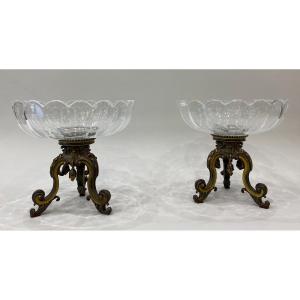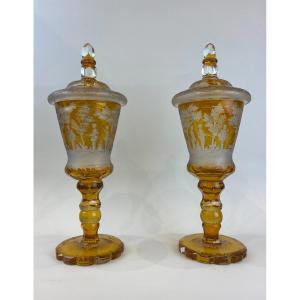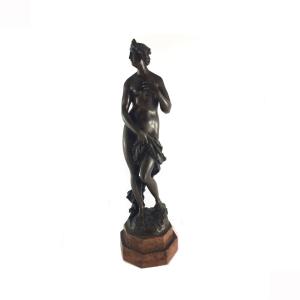French work
Circa 1890
Biography Auguste Louis Mathurin MOREAU (1834-1917)
Auguste Louis Mathurin MOREAU, known as Auguste MOREAU, belongs to the Moreau family, a dynasty of sculptors from the 19th and early 20th centuries. He is the son of Jean-Baptiste-Louis-Joseph Moreau and the younger brother of sculptors Hippolyte Moreau and Mathurin Moreau. While his parents ran a café-guinguette, Le Salon de Mars in Saint-Saulve, the young Auguste was indistinguishable from the children of the village and was a dull schoolboy. He meets Auguste Meurice, a painter and decorator from Valenciennes who frequents his parents' establishment and befriends him. By this frequentation, he made the acquaintance of several students of the Academy of painting of Valenciennes and around 16 years old enrolled in the Academy. He follows the courses of Julien Poitier. He executed portraits of his entourage and of the villagers that he managed to sell, first at affordable prices, then better and better, and obtained a few commissions for religious subjects for the churches of the region. He perfected himself through practice and became a sought-after local painter. From 1872, he sent paintings to the Salon des arts valenciennes and was elected a member of the Society of Agriculture, Sciences and Arts of Valenciennes. In 1873, he made his first shipment to the Paris Salon; he will then be present there almost every year but will not win any prizes. Until 1880, he signed his paintings "Auguste Moreau", he then added the name of his wife "Deschanvres" to avoid confusion with namesakes. In 1902, he obtained an important commission for a series of portraits of the archbishops of Cambrai1. He was named pontifical knight in the order of Saint-Grégoire-le-Grand, probably in recognition of the many portraits he made of dignitaries of the Catholic Church in the North. Genre painter and portrait painter, Auguste Moreau-Deschanvres never left his native region where he had found all his inspiration. Shortly after his death, from March 23 to April 6, 1913, 150 paintings and drawings were exhibited in his studio and put up for sale.
Biography Mathurin MOREAU (1822-1912)
Mathurin Moreau, who owes his first name to his paternal grandfather, a locksmith in Dijon, was born at 7, rue Monge (then still called rue Saint-Jean) from the marriage of the sculptor Jean-Baptiste-Louis -Joseph Moreau and Anne Marianne Richer, originally from Besançon where his father, Mathieu Richer, is also a sculptor1. His brothers Hippolyte and Auguste are also sculptors. He was admitted to the School of Fine Arts in Paris in 1841 in the workshops of Jules Ramey and Auguste Dumont2. He won the second Prix de Rome in 1842 with Diodème removing the Palladium. He made his debut at the Salon des artistes français in 1848 and stood out there with the statue L'Élégie. He obtained a second class medal at the Universal Exhibition of 1855 in Paris, then a first class medal in 1878. In 1897, he was crowned with a medal of honor at the Salon2 of which he became a member of the jury during the Exhibition Universal of 1900 in Paris. He then exhibited a white marble bust representing Ishmael, son of Abraham and Hagar (after his bust in Carrara marble and bronze from 1875, entitled: Ishmael, candor). Between 1849 and 1879, Mathurin Moreau collaborated with the Val d'Osne art foundry and, as a shareholder, became one of its administrators, but, observes Pierre Kjellberg, "the reign of Napoleon III is also that of mantelpieces , and these hitherto very rare sets are multiplying and often feature in the catalogs of bronze publishers”: Mathurin Moreau's Reader is part of this craze3. The artist also provided models to the Compagnie des bronzes de Bruxelles and exhibited at the Central Union of Fine Arts Applied to Industry in the 1880s. In 1880, the artist received a bonus in the competition for the erection of an allegorical monument of La Défense de Paris at the Courbevoie roundabout (the roundabout at the origin of the La Défense district), but it is to Louis-Ernest Barrias that the commission is attributed. From 1879 and until his death, Mathurin Moreau was elected mayor of the 19th arrondissement of Paris — created in 1860 after the annexation of the municipalities of Belleville and La Villette — where rue Priestley took the name of avenue Mathurin-Moreau under of the decree of July 16, 1912. The satirical magazine Les Hommes d'Aujourd'hui devotes its n°183 to him, the portrait-charge drawn by Henri Demare on the cover showing him wearing the tricolor scarf and pointing to an allegorical statue of the law whose base crushes the clergy, "alluding to his liberal socialist opinions turned towards free-thinking". He celebrated many marriages: the painting painted by Henri Gervex in 1884 and hung in the marriage hall of the town hall represents Mathurin Moreau celebrating the civil marriage of his son. He was named Knight of the Legion of Honor in 1865 and promoted to officer of the same order in 18852. He died on February 14, 1912 in his home at 15 Passage du Montenegro in the 19th arrondissement of Paris. His funeral took place at the Saint-Jean-Baptiste church in Belleville and he was buried in the Lilas cemetery.






























 Le Magazine de PROANTIC
Le Magazine de PROANTIC TRÉSORS Magazine
TRÉSORS Magazine Rivista Artiquariato
Rivista Artiquariato
